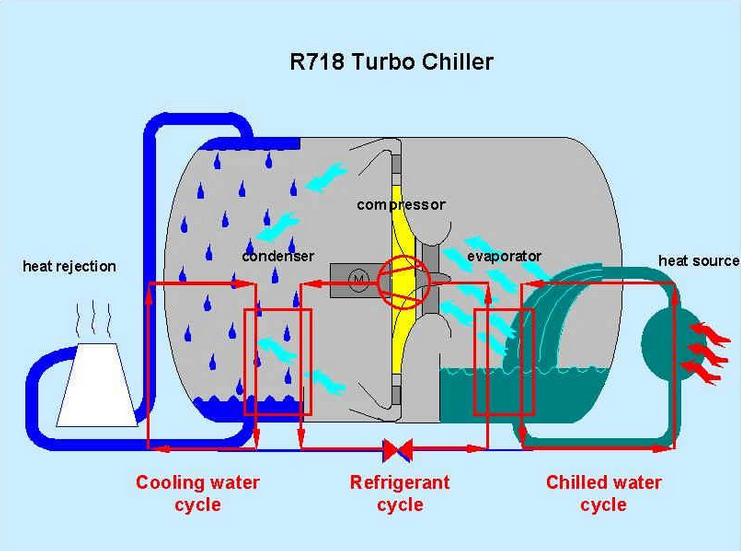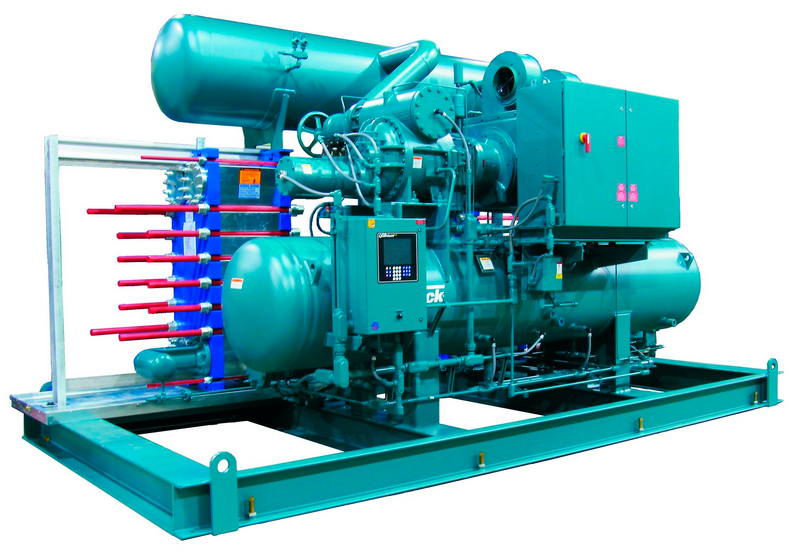A chiller is a machine that removes heat from a liquid via a vapor-compression or absorption refrigeration cycle. This liquid can then be circulated through a heat exchanger to cool air or equipment as required. As a necessary byproduct, refrigeration creates waste heat that must be exhausted to ambient or, for greater efficiency, recovered for heating purposes.
Concerns in design and selection of chillers include performance, efficiency, maintenance, and product life cycle environmental impact. Industrial chillers are classified as a refrigeration system that cools a process fluid or dehumidifies air in commercial and industrial facilities. A chiller will use either a vapor compression or absorption cycle to cool. Chilled water has a variety of applications from space cooling to process uses.

How It Works
The thermodynamic cycle of an absorption chiller is driven by a heat source; this heat is usually delivered to the chiller via steam, hot water, or combustion. Compared to electrically powered chillers, an absorption chiller has very low electrical power requirements – very rarely above 15 kW combined consumption for both the solution pump and the refrigerant pump. However, its heat input requirements are large, and its COP is often 0.5 (single-effect) to 1.0 (double-effect). For the same tonnage capacity, an absorption chiller requires a much larger cooling tower than a vapor-compression chiller. However, absorption chillers, from an energy-efficiency point of view, excel where cheap, high-grade heat or waste heat is readily available. In extremely sunny climates, solar energy has been used to operate absorption chillers.
The single-effect absorption cycle uses water as the refrigerant and lithium bromide as the absorbent. It is the strong affinity that these two substances have for one another that makes the cycle work. The entire process occurs in almost a complete vacuum.
-
Solution Pump
A dilute lithium bromide solution is collected in the bottom of the absorber shell. From here, a hermetic solution pump moves the solution through a shell and tube heat exchanger for preheating.
-
Generator
After exiting the heat exchanger, the dilute solution moves into the upper shell. The solution surrounds a bundle of tubes which carries either steam or hot water. The steam or hot water transfers heat into the pool of dilute lithium bromide solution. The solution boils, sending refrigerant vapor upward into the condenser and leaving behind concentrated lithium bromide. The concentrated lithium bromide solution moves down to the heat exchanger, where it is cooled by the weak solution being pumped up to the generator.
-
Condenser
The refrigerant vapor migrates through mist eliminators to the condenser tube bundle. The refrigerant vapor condenses on the tubes. The heat is removed by the cooling water which moves through the inside of the tubes. As the refrigerant condenses, it collects in a trough at the bottom of the condenser.
-
Evaporator
The refrigerant liquid moves from the condenser in the upper shell down to the evaporator in the lower shell and is sprayed over the evaporator tube bundle. Due to the extreme vacuum of the lower shell [6 mm Hg (0.8 kPa) absolute pressure], the refrigerant liquid boils at approximately 39 °F (4 °C), creating the refrigerant effect. (This vacuum is created by hygroscopic action – the strong affinity lithium bromide has for water – in the Absorber directly below.)
-
Absorber
As the refrigerant vapor migrates to the absorber from the evaporator, the strong lithium bromide solution from the generator is sprayed over the top of the absorber tube bundle. The strong lithium bromide solution actually pulls the refrigerant vapor into solution, creating the extreme vacuum in the evaporator. The absorption of the refrigerant vapor into the lithium bromide solution also generates heat which is removed by the cooling water. Now the dilute lithium bromide solution collects in the bottom of the lower shell, where it flows down to the solution pump. The chilling cycle is now completed and the process begins once again.
PES can rebuild and coat chiller tube sheets with epoxy metals and ceramic coatings for extended life of the chiller.
We provide the most up to date epoxy and coating products for the repair to chiller tube sheets, water boxes, and end covers to prevent further deterioration of the wetted components from erosion and corrosion. PES offers the BEST warranty in the industry. PES is licensed in the state of Texas, and all employees have been background checked.

